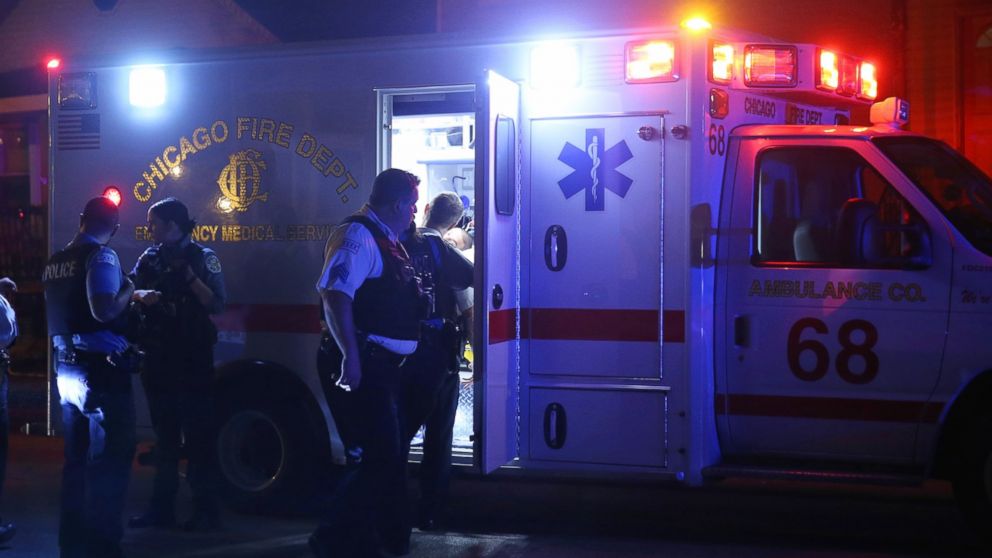Nearly 1 in 5 Trauma Patients in Chicago Area Treated in Ill-Equipped Hospitals, Study Finds
Many have pushed for more trauma centers in the Chicago area.

— -- With dramatic increases in shootings and homicides in Chicago in recent years, more and more patients are being taken to hospitals with traumatic injuries. However, a new study finds that many patients with traumatic injuries are being taken to hospitals not designated to handle these type of wounds.
Nearly one-fifth of patients who should have been taken to a designated level 1 trauma center from 2009 to 2013 were instead taken to community hospitals in the Chicago area that are not fully equipped to deal with these traumatic cases, according to a new study published today in JAMA Surgery.
The city has long struggled with a lack of hospitals that are level 1 trauma centers, meaning they are designated specifically for the most serious types of traumatic injuries. If a hospital is a level 1 trauma center, it must meet a variety of requirements so that it can be "capable of providing total care for every aspect of injury -- from prevention through rehabilitation," according to the American Trauma Society.
Patients with life-threatening injuries, such as a penetrating injury in the torso or any injury that impairs breathing, are supposed to be taken to a level 1 trauma center immediately or stabilized at a community hospital before being quickly moved to a level 1 trauma center for further care.
Chicago has four level 1 trauma centers in the city limits and 19 in Cook County, which encompasses the city. However, in the southern parts of the county, there are few level 1 trauma centers, despite increasing rates of violence in the area, the study noted.
"The lower third of county, which holds 700,000 people, has no trauma unit," Lee Friedman, a co-author of the study and associate professor at the University of Illinois at Chicago School of Public Health, told ABC News.
Researchers from the University of Illinois at Chicago School of Public Health examined hospital databases to understand how 9,886 patients with gunshot wounds were treated at various hospitals from 2009 to 2013. They found 4,934 patients with injuries severe enough that they should have been taken to a level 1 trauma center.
However, of these patients, 884, or 17.9 percent, were undertriaged, or initially taken to a hospital not designated to handle these types of injuries, the study found. Once those patients were at the community hospitals, the researchers found 90 percent were not transferred to a level 1 trauma center designated to care for severe injuries.
While the study was not designed to discover how these patients got to the hospital, Friedman said during their research they heard from many physicians that the injured were being driven in by family or friends in search of care.
"People are being self-transported to these community hospitals ... It's not a failure of EMS," Friedman said. "It's people saying, 'Let's get this person to [any hospital].'"
Friedman and his co-authors concluded that there should be better coordination among hospitals and support for these hospitals in areas with high levels of violence. Hospitals not designated as trauma centers are facing additional burdens for caring for these patients without the financial support they would get if they were designated as a lower-tier trauma center, Friedman noted.
"They're unrecognized as level 3, level 4 trauma units," said Friedman, explaining these hospitals were not getting recognition for treating these traumatic injuries. "What this study is showing is that even in a really efficient system, there is room for improvement."
Dr. Marie Crandall, of the University of Florida College of Medicine in Jacksonville, Florida, wrote in an accompanying commentary in JAMA Surgery that more research needs to be done to understand how these findings could be applied.
It's possible that the undertriaged patients may have been shot in the hand or foot, in which case it could be appropriate for them to be treated at a local hospital not designated for traumatic injuries, Crandall noted.
"This article provides an important first look at whether patients with firearm-related injuries in Chicago have appropriate access to trauma care," Crandall said in the commentary. "However, more work needs to be done before conclusions can be drawn or action plans can be discussed about undertriage."